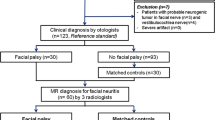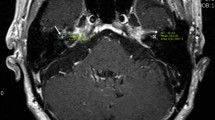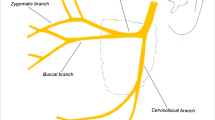Abstract
Background
MRI is the modality of choice for the imaging of facial neuritis. Previously, gadolinium-enhanced T1-weighted imaging of the petrous bone, then FLAIR sequences were thought to be most informative for acute facial neuritis imaging. The aim of this study is to evaluate the value of contrast-enhanced T2-weighted sequence for the diagnosis of acute facial neuritis and compare it to contrast-enhanced T1-weighted and FLAIR sequences.
Methods
We included 50 patients with an acute unilateral idiopathic peripheral facial neuritis. An MRI (3 T) with three sequences was performed (T1-weighted, T2-weighted and FLAIR), all acquired after intravenous contrast-media injection.
Results
The contrast-enhanced T2-weighted sequence appeared to be the most accurate one for the diagnosis of acute facial neuritis (Se 94%, Sp 100%, accuracy 98.2%, p < 0.001), with a pathological facial nerve strongly (grade 2–3) enhancing and a homogenous enhancement along the course of the entire facial nerve. Contrast-enhanced T1-weighted (Se 80%, Sp 100%, accuracy 94.1%) and FLAIR sequences (92%, Sp 88%, accuracy 90%, p < 0.001) showed lower accuracy. On T1-weighted sequence, a strong enhancement (blurred margins) of the canalicular segment was observed in 80% of the cases when it was never observed in normal nerves.
Conclusion
A strong (= iso to hyperintense to the petrous fat signal) and diffuse (all segments) enhancement of the facial nerve on T2-weighted steady-state free precession sequence is a sensitive and specific sign for the diagnosis of acute idiopathic facial neuritis, and appears superior to T1WI and FLAIR sequences.






Similar content being viewed by others
Abbreviations
- SSFP:
-
Steady-state free precession
- FIESTA-C:
-
Fast imaging employing steady-state acquisition with cycle phase
- IAC:
-
Internal auditory canal
- IV:
-
Intravenous
References
Balkany T, Fradis M, Jafek BW, Rucker NC (1991) Intrinsic vasculature of the labyrinthine segment of the facial nerve—implications for site of lesion in Bell's palsy. Otolaryngol Head Neck Surg 104(1):20–23
Sartoretti-Schefer S, Wichmann W, Valavanis A (1994) Idiopathic, herpetic, and HIV-associated facial nerve palsies: abnormal MR enhancement patterns. Am J Neuroradiol 15(3):479–485
Girard N, Poncet M, Chays A, Florence A, Gignac D, Magnan J, Raybaud C (1993) MRI exploration of the intrapetrous facial nerve. J Neuroradiol 20(4):226–238
Sartoretti-Schefer S, Kollias S, Wichmann W, Valavanis A (1998) T2-weighted three-dimensional fast spin-echo MR in inflammatory peripheral facial nerve palsy. Am J Neuroradiol 19(3):491–495
Jackson CG, Hyams VJ, Johnson GD, Poe DS (1990) Pathologic findings in the labyrinthine segment of the facial nerve in a case of facial paralysis. Ann OtolRhinolLaryngol 99(5):327–329
Gebarski SS, Telian SA, Niparko JK (1992) Enhancement along the normal facial nerve in the facial canal: MR imaging and anatomic correlation. Radiology 183(2):391–394
Martin-Duverneuil N, Sola-Martinez MT, Miaux Y, Cognard C, Weil A, Mompoint D, Chiras J (1997) Contrast enhancement of the facial nerve on MRI: normal or pathological? Neuroradiology 39(3):207–212
Engström M, Thuomas KÅ, Naeser P, Stålberg E, Jonsson L (1993) Facial nerve enhancement in Bell's palsy demonstrated by different gadolinium-enhanced magnetic resonance imaging techniques. Arch Otolaryngol Head Neck Surg 119(2):221–225
Daniels DL, Czervionke LF, Pojunas KW, Meyer GA, Millen SJ, Williams AL, Haughton VM (1987) Facial nerve enhancement in MR imaging. Am J Neuroradiol 8(4):605–607
Becelli R, Perugini M, Carboni A, Renzi G (2003) Diagnosis of Bell palsy with gadolinium magnetic resonance imaging. J CraniofacSurg 14(1):51–54
Kress B, Griesbeck F, Stippich C, Bähren W, Sartor K (2004) Bell palsy: quantitative analysis of MR imaging data as a method of predicting outcome. Radiology 230(2):504–509
Santos DQ, Adour KK (1993) Bilateral facial paralysis related to sexually transmitted herpes simplex: clinical course and MRI findings. Otolaryngol Head Neck Surg 108(3):298–303
Hong HS, Yi BH, Cha JG, Park SJ, Kim DH, Lee HK, Lee JD (2010) Enhancement pattern of the normal facial nerve at 3.0 T temporal MRI. Br J Radiol 83(986):118–121
Yetiser S, Kazkayas M, Altınok D, Karadeniz Y (2003) Magnetic resonance imaging of the intratemporal facial nerve in idiopathic peripheral facial palsy. Clin Imaging 27(2):77–81
Nakata S, Mizuno T, Naganawa S et al (2010) 3D-FLAIR MRI in facial nerve paralysis with and without audio-vestibular disorder. Acta Otolaryngol 130:632–636. https://doi.org/10.3109/00016480903338123
Lim HK, Lee JH, Hyun D et al (2012) MR diagnosis of facial neuritis: diagnostic performance of contrast-enhanced 3D-FLAIR technique compared with contrast-enhanced 3D–T1-fast-field echo with fat suppression. AJNR Am J Neuroradiol 33:779–783. https://doi.org/10.3174/ajnr.A2851
Chung MI, Lee JH, Kim DY et al (2015) The clinical significance of findings obtained on 3D-FLAIR MR imaging in patients with Ramsay–Hunt syndrome. Laryngoscope 125:950–955. https://doi.org/10.1002/lary.24973
Liston SL, Kleid MS (1989) Histopathology of Bell's palsy. Laryngoscope 99(1):23–26
Shigematsu Y, Korogi Y, Hirai T, Okuda T, Ikushima I, Sugahara T, Takahashi M et al (1999) Contrast-enhanced CISS MRI of vestibular schwannomas: phantom and clinical studies. J Comput Assist Tomogr 23(2):224–231
Funding
No funding was received for this study.
Author information
Authors and Affiliations
Corresponding author
Ethics declarations
Conflict of interest
The authors have no conflict of interest.
Ethical approval
All procedures performed in studies involving human participants were in accordance with the ethical standards of the institutional and/or national research committee and with the 1964 Helsinki Declaration and its later amendments or comparable ethical standards.
Informed consent
Informed consent was obtained from all participants included in the study.
Additional information
Publisher's Note
Springer Nature remains neutral with regard to jurisdictional claims in published maps and institutional affiliations.
Rights and permissions
About this article
Cite this article
Hector, M., Alnadji, A., Veillon, F. et al. Imaging of facial neuritis using T2-weighted gradient-echo fast imaging employing steady-state acquisition after gadolinium injection. Eur Arch Otorhinolaryngol 278, 2501–2509 (2021). https://doi.org/10.1007/s00405-020-06375-z
Received:
Accepted:
Published:
Issue Date:
DOI: https://doi.org/10.1007/s00405-020-06375-z




